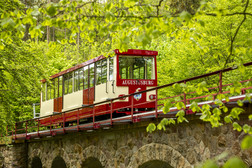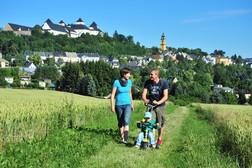Augustusburg Castle, the "crown of the Ore Mountains", can be seen from afar and is undoubtedly the landmark of the small town of the same name with its 4,500 inhabitants. The first castle is documented as early as the 11th century, while the hunting lodge we know today was built by Elector Augustus I of Saxony within four years from 1568. With its exciting museums such as the motorbike museum and the castle museum, special exhibitions and exciting guided tours, as well as its youth hostel, the castle, together with the castle church and its Cranach-Altar, is an attraction for young and old alike. A visit up here can be wonderfully combined with a stroll through the historic old town or the Kurfürstin-Anna-Garten, which was created in 2018 and pays homage to Augustus' wife, who dedicated herself to herbalism.
In addition, the Augustusburg Music Summer, the castle theatre and numerous events and art exhibitions attract culture lovers from near and far to Augustusburg. Visitors to the state-recognised resort will also find peace and quiet and can explore nature on well-signposted hiking trails. Leisure fun for the whole family awaits visitors on the summer toboggan run, at mini golf or in the Erdmannsdorf outdoor pool. In any case, a trip on the historic Erdmannsdorf-Augustusburg cable car is also part of a successful stay in Augustusburg.














































